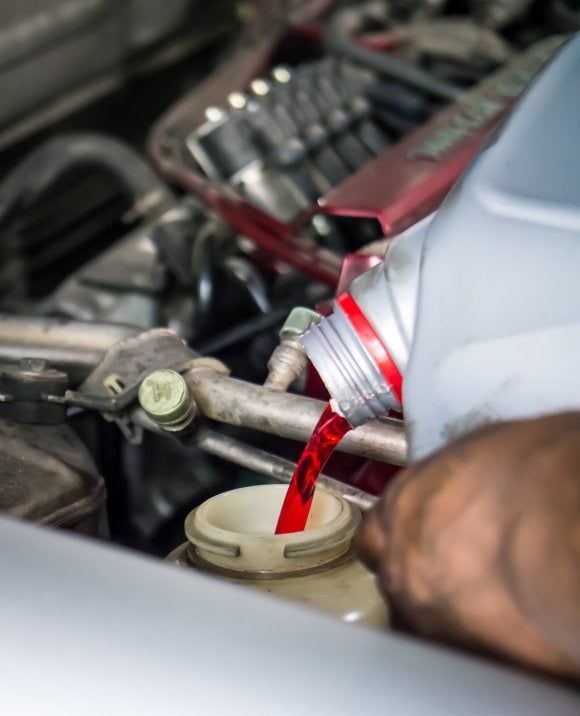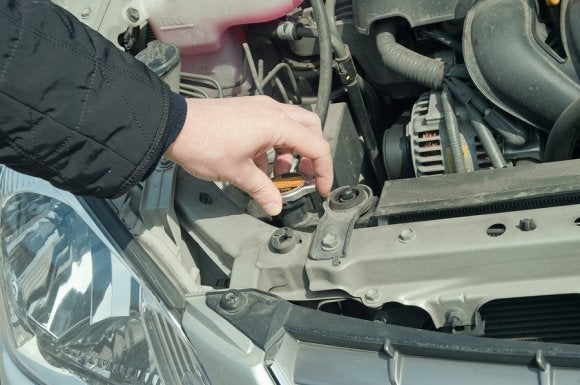-
Maintaining Your Honda’s Transmission
Do you have a 1998 Honda Accord? If so, this video will show you exactly where the transmission fluid dipstick is located and tell you how to add transmission fluid. If you drive a different year, make, or model, this video is still beneficial as it provides some general tips for checking and adding transmission fluid to your vehicle.
To keep your Honda in tip-top shape, visit a transmission repair shop in Silver Spring, MD that specializes in Honda transmission service . Trusting your vehicle with technicians who know the ins and outs of Honda transmission maintenance and repair will give you the peace of mind of knowing that your vehicle is in the best hands for the job. For transmission problems big and small, visit Superior Transmissions. Call (301) 960-2282 to learn more about the Honda transmission services offered by Superior Transmissions.
-
A Car Owner’s Guide to Selecting Automatic Transmission Fluid
If you take your car to a transmission service shop in Bethesda for routine maintenance, you can leave it up to the professionals to select the best fluid for your automatic transmission. However, if you’re the do-it-yourself type you will need to choose your own transmission fluid when changing out the old fluid. It’s recommended that you leave this maintenance service to the professionals, but if you insist on changing your own transmission fluid make sure you choose the right fluid to prevent damaging your car’s transmission. Here are some important things to know about selecting automatic transmission fluid for your vehicle.

When to Change Transmission Fluid
First and foremost, when talking about transmission fluid it’s important that you know when you need to change the fluid inside your transmission. Generally, transmission fluid should be changed every 24,000 to 36,000 miles, or approximately every two to three years. Refer to your car’s owner’s manual for more specific transmission fluid change interval information related to your make and model. You can also ask your transmission technician for a recommended fluid change interval based on the condition of your transmission.
Automatic Transmission Fluid Types
There are two main types of transmission fluid, Dextron and Mercon. Your owner’s manual will tell you which type of transmission fluid your vehicle uses. You will also need to decide between synthetic and conventional transmission fluid . Synthetic fluid is more expensive than conventional oil, but it performs better at higher temperatures and provides better overall protection. However, if you drive an older vehicle the transmission might not be designed with synthetic fluid in mind.
Transmission Fluid Brands
When it comes to brands, there’s little difference between the major transmission fluid brands. If you want a specific brand recommendation, check with a transmission repair shop in your area or ask for a recommendation at the auto parts store you frequent to purchase fluid.
-
Checking Your Manual Transmission Fluid
You don’t have to be a transmission repair expert to keep your transmission in great shape. Routinely checking the fluid, for example, can clue you in to potential problems with your transmission and help you avoid running on low fluid which can strain the transmission and shorten its life. But how exactly do you check the transmission fluid anyways? You can see how by watching this video from an ASE-certified master mechanic.
If you notice your transmission fluid is very dirty or smells burnt, visit a transmission repair shop in Montgomery County MD for a transmission flush service . This will completely flush out the dirty, slugged-up fluid so fresh transmission can be added to the system. Clean fluid is essential to transmission lubrication, and a well-lubricated transmission runs better and has a longer lifespan than transmissions that become worn down due to poor lubrication.
-
How to Tell When Your Car Needs a Transmission Flush
Generally speaking, it’s a good idea to get a transmission flush every 30,000 miles or every two years, whichever comes first. However, depending on the age and condition of your transmission and other factors such as how you drive and how well you maintain your transmission, there may be times when you need to get a transmission flush sooner. If you recognize any of these common signs, visit a transmission shop in Rockville, and Bethesda for a transmission flush service.

Problems Shifting Gears
Regardless of whether you drive an automatic or manual, problems shifting gears is an indication that the transmission fluid contains too much dirt or sludge which is causing a sluggish response in the gearbox. For automatic transmissions, you may notice that the vehicle changes gears faster or slower than normal. In manual transmission vehicles, you may it very difficult to change the gears at all. In either case, visit a transmission repair shop to find out if a flush is the answer to the problems you are experiencing.
Vehicle Surging
Another tell-tale sign of a transmission in need of a flush and fill is unexplainable surging of the vehicle. Transmission fluid that is very dirty or full of sludge does not allow for adequate flow through the transmission, which can cause the vehicle to surge forward for no good reason. This problem is usually most noticeable when the vehicle slows down and comes to a stop at a light or stop sign.
Dirty or Burnt-Smelling Transmission Fluid
As a part of maintaining your vehicle, get in the habit of inspecting the transmission fluid on a regular basis. If the fluid looks very dirty or smells burnt, visit a transmission repair shop in Silver Spring, MD for a flush service so you can have fresh fluid added for optimal performance, lubrication, and efficiency.
-
The Purpose of Transmission Fluid
Routine maintenance is an essential part of car ownership. Along with scheduling regular oil changes, tire rotations, and other services, you should also be sure to check your transmission fluid levels often . Low transmission fluid is the cause of many problems. When you change your transmission fluid at regularly scheduled intervals, you can help prevent some of the most common transmission repair issues that could plague your vehicle. A transmission specialist near Silver Spring, MD will be able to help you determine when your transmission fluid is too low. Read on for an overview of the role that transmission fluid plays in your vehicle.

How Transmissi on Fluid Works
Transmission fluid is a vital part of both automatic and manual transmission systems. When your transmission is in operation, your transmission fluid is designed to lubricate and protect the many moving parts that are used for your transmission to operate. Automatic transmissions also rely on transmission fluid to deliver power from the engine to the components of the transmission. Without properly maintained transmission fluid, your transmission would cease to function.
The Importance of Transmission Fluid Changes
Transmission specialists typically recommend that you change your transmission fluid between every 30,000 and 60,000 miles. Transmission fluid changes are essential for preserving the performance, safety, and longevity of your car. When you change your transmission fluid, you will remove harmful contaminants that could cause damage to your system. In addition, since transmission fluid breaks down over time, you can help prevent your transmission from degrading.
Potential Transmission Fluid Problems
Failing to follow the transmission fluid changing schedule for your vehicle could lead to very serious mechanical problems. For example, if you neglect to change your transmission fluid, the many moving components of your transmission could become damaged by metal shavings and other contaminants. In addition, routine transmission fluid changes could also help you avoid the need for a transmission rebuild in the future.
-
A Look at Synthetic Transmission Fluid
When you schedule transmission repair in Washington, D.C., Northern Virginia, or near Baltimore, MD, your transmission specialist may need to change your transmission fluid . In order to get the most out of this transmission service, it is important to make sure that you choose the right fluid for your automatic transmission. With a transmission fluid that is designed to work properly in all types of original and rebuilt transmissions, you can rest assured that your vehicle is receiving the proper level of cooling, lubrication, and power. Your transmission shop will be able to help you select the best transmission fluid for your vehicle. To learn more about the benefits of using synthetic transmission fluid, be sure to check out this video from Scotty Kilmer.
-
The Importance of Transmission Fluid
Of all the fluids inside your vehicle, transmission fluid is one of the most important. Driving with low or dirty transmission fluid can cause excessive wear and tear that ultimately leads to unexpected transmission issues. Like any other vital automotive fluid, transmission fluid deteriorates over time. Consult your owner’s manual or talk with your transmission repair shop in Washington DC to determine the best fluid maintenance schedule for your vehicle. Here are some important things to know about transmission fluid.

What Transmission Fluid Does
Transmission fluid helps keep your car’s automatic or manual transmission cool and lubricated. In automatic transmissions, this fluid also serves as a viscous fluid that transmits power from the engine to the transmission. Manual transmission fluids contain a variety of oils, including regular motor oil and heavyweight hypoid gear oil.Types of Transmission Fluid
If you’ve been to an auto parts store recently, you know that there are lots of different types of transmission fluids to choose from. Different fluid specifications use different additives and ingredients to achieve specific fluid properties and performance. Drivers also have a choice between conventional and synthetic transmission fluids. Synthetic fluids can be twice as expensive as conventional fluids but offer better performance and improved resistance to heat, cold, oxidation, friction, and shearing.Transmission Fluid Maintenance
Regardless of whether you have a manual or automatic transmission, you need to inspect the level and condition of the transmission fluid on a regular basis. If your transmission is low on fluid, look for signs of a leak. When checking the fluid’s condition, be on the lookout for fluid that is dark or smells burnt. If your transmission fluid is dirty or burnt smelling, bring your vehicle to a Washington DC transmission repair shop for a fluid flush and fill. -
Should You Replace Transmission Fluid?
 This is one of the most commonly asked questions regarding transmission maintenance. In reality, it’s not a matter of if you should replace your transmission fluid, but when. Over time transmission fluid becomes dirty and is less effective at keeping the transmission cooled and lubricated. To determine how often you should replace your vehicle’s transmission fluid, refer to the owner’s manual or ask your transmission repair provider in Washington DC . While there’s no harm with frequent fluid changes, putting off a transmission flush and fluid refill can cause major problems down the road.
This is one of the most commonly asked questions regarding transmission maintenance. In reality, it’s not a matter of if you should replace your transmission fluid, but when. Over time transmission fluid becomes dirty and is less effective at keeping the transmission cooled and lubricated. To determine how often you should replace your vehicle’s transmission fluid, refer to the owner’s manual or ask your transmission repair provider in Washington DC . While there’s no harm with frequent fluid changes, putting off a transmission flush and fluid refill can cause major problems down the road.Although you should let a professional change your car’s transmission fluid, you can (and should) check the fluid level and condition on a regular basis. If the fluid smells burnt or looks very dirty, visit a transmission repair shop in Washington DC for service. You should also bring your car in if you notice leaking transmission fluid.
-
Signs that Your Transmission Needs a Fluid Flush
Taking care of your transmission is important if you want your vehicle to function properly in the long run. Fortunately, your car often notifies you of any transmission problems it may be having in a variety of ways. It is a good idea to seek auto transmission repair near Washington D.C. as soon as you notice any of these indications. Read on for a few signs that your transmission needs a fluid flush.

Delays
One sign that you are having transmission issues is the hesitation or reluctance that your vehicle may exhibit before carrying out your commands. You may notice this if you put your car in gear and then experience a stall before the car begins to move. This type of sign typically indicates that your transmission fluid is contaminated and should be diagnosed and treated by a qualified transmission shop. Since your transmission fluid is critical to the proper functioning of your car, it is wise to take care of this issue before additional problems are created .Noises
Rarely will there be a time where strange noises do not indicate a problem with machinery. When it comes to your car, the presence of grinding or grunting noises warrants an immediate inspection of your transmission fluid; without turning the engine off, check the transmission fluid level in your car. If there is an appropriate level of fluid, check its color. Transmission fluid that is brown or black has likely been contaminated with sludge and grime and should be taken to a transmission shop for repairs. The symptom of strange noises coming from your car may also exist if your transmission fluid is clean but lacking in quantity.Slipping
Your car needs power and pressure in order to properly stay in the appropriate gear and function in an optimal manner. If you do not have enough transmission fluid or the fluid that you do have is contaminated, your vehicle will have trouble maintaining the proper gear. This can impair your car’s maneuverability and lead to more severe problems with your cars mechanics in the future, so check your transmission fluid if you experience gear slipping. -
Signs That Your Transmission is Low on Fluid
When your transmission fluid is low, a number of transmission problems can arise. Your transmission fluid is responsible for lubricating, powering, and cooling your transmission. Without enough transmission fluid, you may find that your vehicle is unable to move forward. In addition, your car may experience transmission problems such as gearset failures and bearing failures. This could result in symptoms such as a burning smell coming from your transmission. A shop specializing in auto transmission repair can replace and replenish your low transmission fluid. When you change transmission fluid on a routine basis, you can eliminate the dangers of low fluid. If you are concerned about the health of your transmission, be sure to schedule a transmission fluid change in the D.C. Metro Area. For a closer look at the signs that your transmission is low on fluid, watch this video from ehowauto.
